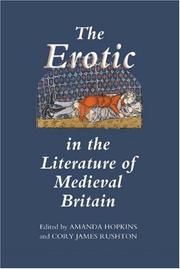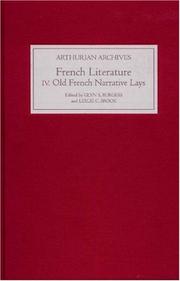| Listing 1 - 10 of 11 | << page >> |
Sort by
|

ISBN: 9781843841197 1843841193 9781846155406 9786612185373 1282185373 1846155401 Year: 2007 Publisher: Suffolk Boydell & Brewer
Abstract | Keywords | Export | Availability | Bookmark
 Loading...
Loading...Choose an application
- Reference Manager
- EndNote
- RefWorks (Direct export to RefWorks)
This volume examines the erotic in the literature of medieval Britain, primarily in Middle English, but also in Latin, Welsh and Old French. Seeking to discover the nature of the erotic and how it differs from modern erotics, the contributors address topics such as the Wife of Bath's opinions on marital eroticism, the role of clothing and nudity, the tension between eroticism and transgression, the interplay between religion and the erotic, and the hedonistic horrors of the cannibalistic Giant of Mont St Michel. Contributors: ALEX DAVIS, SIMON MEECHAM-JONES, JANE BLISS, SUE NIEBRZYDOWSKI, KRISTINA HILDEBRAND, ANTHONY BALE, CORY JAMES RUSHTON, CORINNE SAUNDERS, AMANDA HOPKINS, ROBERT ROUSE, MARGARET ROBSON, THOMAS H. CROFTS III, MICHAEL CICHON. AMANDA HOPKINS teaches in the department of English and Comparative Literary Studies and the department of French at the University of Warwick. CORY RUSHTON is in the Department of English at St. Francis Xavier University, Nova Scotia, Canada.
Literature, Medieval --- Eroticism in literature. --- Littérature médiévale --- Erotisme dans la littérature --- History and criticism. --- Histoire et critique --- Littérature médiévale --- Erotisme dans la littérature --- English literature --- Great Britain --- Literatures --- Erotica in literature --- Érotisme --- Littérature anglaise --- Dans la littérature --- 450-1100 (vieil anglais) --- Thèmes, motifs --- British literature
Digital
ISBN: 9781846155406 Year: 2007 Publisher: Suffolk Boydell & Brewer
Abstract | Keywords | Export | Availability | Bookmark
 Loading...
Loading...Choose an application
- Reference Manager
- EndNote
- RefWorks (Direct export to RefWorks)
Book
ISBN: 9782503542508 9782503542638 2503542638 2503542506 Year: 2013 Volume: 15 Publisher: Turnhout Brepols
Abstract | Keywords | Export | Availability | Bookmark
 Loading...
Loading...Choose an application
- Reference Manager
- EndNote
- RefWorks (Direct export to RefWorks)
This book is devoted to the study of multilingual Britain in the later medieval period, from the Norman Conquest to John Skelton. It brings together experts from different disciplines — history, linguistics, and literature - in a joint effort to recover the complexities of spoken and written communication in the Middle Ages. Each author focuses on one specific text or text type, and demonstrates by example what careful analysis can reveal about the nature of medieval multilingualism and about medieval attitudes to the different living languages of later medieval Britain. There are chapters on charters, sermons, religious prose, glossaries, manorial records, biblical translations, chronicles, and the macaronic poetry of William Langland and John Skelton. By addressing the full range of languages spoken and written in later medieval Britain (Latin, French, Old Norse, Welsh, Cornish, English, Dutch, and Hebrew), this collection reveals the linguistic situation of the period in its true diversity and shows the resourcefulness of medieval people when faced with the need to communicate. For medieval writers and readers, the ability to move between languages opened up a wealth of possibilities: possibilities for subtle changes of register, for counterpoint, for linguistic playfulness, and, perhaps most importantly, for texts which extend a particular challenge to the reader to engage with them.
Old English literature --- Historical linguistics --- English language --- anno 1200-1499 --- anno 1100-1199 --- Languages in contact --- Multilingualism --- Manuscripts, Medieval --- Multilinguisme --- --Grande-Bretagne --- --Moyen âge, --- 1066-1520 --- --Colloque --- --2008 --- --Bristol --- --actes --- --Foreign elements --- History --- Foreign elements --- Great Britain --- Languages --- Multilingualism and literature --- Macaronic literature --- Sermons, Medieval --- Sources. --- Foreign elements. --- Variation. --- History and criticism. --- Texts --- To 1500 --- Sources --- Middle English, 1100-1500 --- Variation --- History and criticism --- Sermons [Medieval ] --- English language - Middle English, 1100-1500 - Foreign elements --- Languages in contact - Great Britain - History - To 1500 --- Multilingualism - Great Britain - History - To 1500 --- English language - Great Britain - Foreign elements --- Manuscripts, Medieval - Great Britain --- Moyen âge, 476-1492 --- Colloque --- Grande-Bretagne --- Bristol --- Great Britain - Languages --- Germanic languages
Book
ISBN: 1782043020 184384379X 1843844443 Year: 2014 Publisher: Suffolk : Boydell & Brewer,
Abstract | Keywords | Export | Availability | Bookmark
 Loading...
Loading...Choose an application
- Reference Manager
- EndNote
- RefWorks (Direct export to RefWorks)
It is often said that the past is a foreign country where they do things differently, and perhaps no type of "doing" is more fascinating than sexual desires and behaviours. Our modern view of medieval sexuality is characterised bya polarising dichotomy between the swooning love-struck knights and ladies of romance on one hand, and the darkly imagined and misogyny of an unenlightened "medieval" sexuality on the other. British medieval sexual culture also exhibits such dualities through the influential paradigms of sinner or saint, virgin or whore, and protector or defiler of women. However, such sexual identities are rarely coherent or stable, and it is in the grey areas, the interstices between normative modes of sexuality, that we find the most compelling instances of erotic frisson and sexual expression. This collection of essays brings together a wide-ranging discussion of the sexual possibilitiesand fantasies of medieval Britain as they manifest themselves in the literature of the period. Taking as their matter texts and authors as diverse as Chaucer, Gower, Dunbar, Malory, alchemical treatises, and romances, the contributions reveal a surprising variety of attitudes, strategies and sexual subject positions. Contributors: Aisling Byrne, Anna Caughey, Kristina Hildebrand, Amy S. Kaufman, Yvette Kisor, Megan G. Leitch, Cynthea Masson, Hannah Priest, Samantha J. Rayner, Robert Allen Rouse, Cory James Rushton, Amy N. Vines.
Literature --- Belles-lettres --- Western literature (Western countries) --- World literature --- Philology --- Authors --- Authorship --- History and criticism. --- Literature, Medieval --- English literature --- Sex in literature. --- Alchemical treatises. --- Britain. --- British history. --- Chaucer. --- Eroticism. --- Gender roles. --- Literature. --- Malory. --- Medieval sexuality. --- Medieval. --- Romance. --- Sexual culture. --- anthropology. --- medeival romance. --- medieval English culture. --- medieval English society. --- medieval history. --- sociology. --- women and gender studies. --- women's studies'.
Book
ISBN: 9781843844440 Year: 2016 Publisher: Woodbridge : D.S. Brewer,
Abstract | Keywords | Export | Availability | Bookmark
 Loading...
Loading...Choose an application
- Reference Manager
- EndNote
- RefWorks (Direct export to RefWorks)
An examination into aspects of the sexual as depicted in a variety of medieval texts, from Chaucer and Malory to romance and alchemical treatises. It is often said that the past is a foreign country where they do things differently, and perhaps no type of "doing" is more fascinating than sexual desires and behaviours. Our modern view of medieval sexuality is characterised by a polarising dichotomy between the swooning love-struck knights and ladies of romance on one hand, and the darkly imagined and misogyny of an unenlightened "medieval" sexuality on the other. British medieval sexual culture also exhibits such dualities through the influential paradigms of sinner or saint, virgin or whore, and protector or defiler of women. However, such sexual identities are rarely coherent or stable, and it is in the grey areas, the interstices between normative modes of sexuality, that we find the most compelling instances of erotic frisson and sexual expression. This collection of essays brings together a wide-ranging discussion of the sexual possibilities and fantasies of medieval Britain as they manifest themselves in the literature of the period. Taking as their matter texts and authors as diverse as Chaucer, Gower, Dunbar, Malory, alchemical treatises, and romances, the contributions reveal a surprising variety of attitudes, strategies and sexual subject positions.
English literature --- Sex in literature. --- Littérature anglaise --- Sexualité dans la littérature --- Themes, motives. --- Thèmes, motifs

ISBN: 9781843841180 9781846155437 Year: 2007 Volume: 14 IV Publisher: Cambridge ;Rochester, N.Y. D.S. Brewer
Abstract | Keywords | Export | Availability | Bookmark
 Loading...
Loading...Choose an application
- Reference Manager
- EndNote
- RefWorks (Direct export to RefWorks)
French poetry --- Lays --- Folk songs --- Poetry --- Tales --- Old French poetry --- Rhétoriqueurs (Group of poets)
Multi
ISBN: 9781843843795 9781782043027 Year: 2014 Publisher: Woodbridge Brewer
Abstract | Keywords | Export | Availability | Bookmark
 Loading...
Loading...Choose an application
- Reference Manager
- EndNote
- RefWorks (Direct export to RefWorks)
Old English literature --- History of civilization --- anno 1200-1499 --- Great Britain

ISBN: 1282185403 9786612185403 1846155436 1843841185 Year: 2007 Publisher: Cambridge ; Rochester, N.Y. : D.S. Brewer,
Abstract | Keywords | Export | Availability | Bookmark
 Loading...
Loading...Choose an application
- Reference Manager
- EndNote
- RefWorks (Direct export to RefWorks)
Text and facing translation of a selection of French narrative lays, with Arthurian subject matter and interest. The lay was a flourishing genre in the French courts of the twelfth and thirteenth centuries, related to romance rather as the modern short story is to the novel. Its most famous exponent is arguably Marie de France, but in addition to her twelve lays, a number of others, mainly anonymous, have also come down to us, usually referred to as Breton lays or simply as narrative lays. The eleven anonymous lays presented in this volume show the varied natureof the genre. First brought together as a collection by Prudence Tobin in 1976, they have been freshly edited from the manuscript sources. They are presented here with facing English translation, together with substantial introductions for each lay, which deal principally with thematic issues and questions of general literary interest. GLYN S. BURGESS is Emeritus Professor of French at the University of Liverpool. LESLIE C. BROOK is Honorary Senior Research Fellow in French at the University of Birmingham.
Lays. --- Lays --- French poetry --- Old French poetry --- Rhétoriqueurs (Group of poets) --- Folk songs --- Poetry --- Tales
Book
Year: 2007 Publisher: Woodbridge Brewer
Abstract | Keywords | Export | Availability | Bookmark
 Loading...
Loading...Choose an application
- Reference Manager
- EndNote
- RefWorks (Direct export to RefWorks)
Book
Year: 2007 Publisher: Woodbridge Brewer
Abstract | Keywords | Export | Availability | Bookmark
 Loading...
Loading...Choose an application
- Reference Manager
- EndNote
- RefWorks (Direct export to RefWorks)
| Listing 1 - 10 of 11 | << page >> |
Sort by
|

 Search
Search Feedback
Feedback About UniCat
About UniCat  Help
Help News
News